Gateway to the West
The next day we left Winchester and continued
west along the Interstate. At Frankfort, capital of Kentucky, we left the
motorway to do som shopping. We needed more ice to our cooler and some bread and
stuff for lunch later on. At Louisville we crossed the Indiana state
line.
Louisville is a pretty big city, in Denmark best known for being the home of the
Kentucky Derby. The town spreads on both sides of the Ohio
River, so parts of it, including the suburb Clarksville are actually in Indiana.
Clarksville was originally an independent city and is one of the oldest in the
area. It was founded in 1783 by General George Rogers Clark. At this time Kentucky had no official status, but when
Clark went to Virginia and explained that it was under attack by British troops and also led war against three Indian tribes, Kentucky was admitted
into the U.S. as a county in
Virginia. Clark, who died poor, is not very well known, except by American
Revolution buffs, but four counties and three
cities are named after him, like for instance Clarksburg, West Virginia, which we
had visited two years earlier. Better known is Clark's younger brother,
William Clark, one leading member of the Lewis and Clark expedition that explored the
northwestern United States from 1804to 1806. This was the 200 year anniversary for this
expedition, and we were not allowed to forget it for one minute. Everywhere, that
was ever so remotely connected to
Lewis or Clark celebrated the anniversary with
exhibitions, posters and so on. Thus, also in Louisville, were there was plenty
of posters along the highway.
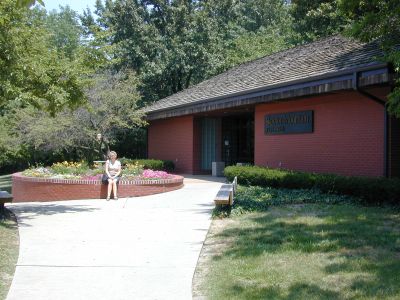 Just after Louisville,
on the Indiana side of the border, we visited the Indiana Welcome Center. Here we chose to eat
some of our recently purchased food. After lunch we walked around a bit on the surrounding area including a "limestone hole." It is a recess in the surface where the
underlying limestone has collapsed, like our Danish sinkholes.
Just after Louisville,
on the Indiana side of the border, we visited the Indiana Welcome Center. Here we chose to eat
some of our recently purchased food. After lunch we walked around a bit on the surrounding area including a "limestone hole." It is a recess in the surface where the
underlying limestone has collapsed, like our Danish sinkholes.
We drove through Indiana with virtually no delay. En route we crossed the time zone from Eastern Standard Time to Central Time, thereby gaining one hour. The timezone was marked by a sign at the roadside, located roughly halfway between two houses. It may require a little coordination to have coffee with the neighbor. "Coffee is ready at 3 PM" will not be enough. You have to add an "our time" or "your time". We continued to the next state line, this time between Indiana and Illinois, known as "The Land of Lincoln" even if Abraham Linbcoln was born in Kentucky and grew up in Indiana. The only president to be born in Illionois is actually Ronald Reagan, who most Danes consider Californian, due to him being governor of this state. This time there was no welcome center, but we got a map at the next rest area. We passed through Illinois, with only one stop to refuel the car and have ourselves a cup of coffee. Gasoline prize had increased dramatically since we were in the U.S. two years earlier. Back then we paid between $ 1.20 and $ 1.30 a gallon. Now, prizes ranged between $ 1.80 and $ 1.95. After refueling we continued to today's goal, St. Louis.
The state line between Illinois and Missouri
at Saint Louis is located in the Mississippi River, and on the east bank you
find East St. Louis, while
St. Louis is on the western shore in Missouri. When we came to East St. Louis we left the
interstate and crossed the river by Dr. Martin Luther King Junior Memorial Bridge.
We quickly found the hotel which we had booked from home: Hampton Inn at the
Arch. We got our room at the hotel, and it appeared to be on 11th floor, with a
magnificent view of St. Louis' skyscrapers on one side, and the Gateway Arch on
the other.
After an hour of relaxation in the room, we went for a walk in town, or rather in the oldest
part of town, which was not very far away. This part of town was named after a
French fur trader, Pierre Laclede, that once settled there, and named the place Lacledes
Landing. There were originally only three streets and these streets still exist,
although they have
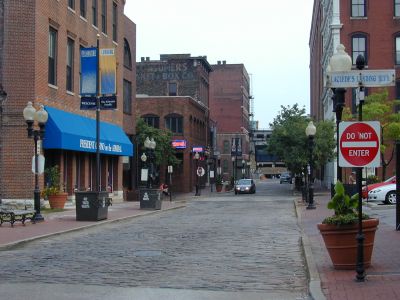 other names. La Grande Rue, the Rue d'Eglise and Rue des
Granges have been to 1st Street, 2nd Street and 3rd Street. Formerly this area
were made up of workshops, warehouses and industry, but today the neighborhood
have become fashionable,
and there are many restaurants, nightclubs, etc. Actually, our plan were toeat at
one of the restaurants and then go back to the hotel. But before we got that
far, we caught sight of a horse, or rather several horses and carriages that that
were ready to take us around town. We began negotiations with a female driver, who turned
out to be named Sue (her horse was named Napoleon, but there wasn't too much imperial
about it) and she could offer two tours, one short and one long. The long lasted
an hour and cost $ 45, which was twice the price of the short, that lasted 25 minutes. We
chose the long, and that made Sue to look happy, but then she could also expect
a larger
tip for the longer trip. She welcomed us to St. Louis Missouri and pronounced it
like misery :-)¨. As usual, we learned a lot about the city's history, and saw some of the old buildings, and as usual it was very interesting. When we got
back to base, we asked Sue if she knew where we could buy St. Louis Rams
equipment. St. Louis Rams is our son Tim's
favorite football team, so he wanted some souvenirs. Sue could tell that there certainly
was not a souvenir shop at their stadium - which otherwise was just next to our
hotel, but at Union Station, we probably
could get what we wanted. So we thanked her and said goodbye.
other names. La Grande Rue, the Rue d'Eglise and Rue des
Granges have been to 1st Street, 2nd Street and 3rd Street. Formerly this area
were made up of workshops, warehouses and industry, but today the neighborhood
have become fashionable,
and there are many restaurants, nightclubs, etc. Actually, our plan were toeat at
one of the restaurants and then go back to the hotel. But before we got that
far, we caught sight of a horse, or rather several horses and carriages that that
were ready to take us around town. We began negotiations with a female driver, who turned
out to be named Sue (her horse was named Napoleon, but there wasn't too much imperial
about it) and she could offer two tours, one short and one long. The long lasted
an hour and cost $ 45, which was twice the price of the short, that lasted 25 minutes. We
chose the long, and that made Sue to look happy, but then she could also expect
a larger
tip for the longer trip. She welcomed us to St. Louis Missouri and pronounced it
like misery :-)¨. As usual, we learned a lot about the city's history, and saw some of the old buildings, and as usual it was very interesting. When we got
back to base, we asked Sue if she knew where we could buy St. Louis Rams
equipment. St. Louis Rams is our son Tim's
favorite football team, so he wanted some souvenirs. Sue could tell that there certainly
was not a souvenir shop at their stadium - which otherwise was just next to our
hotel, but at Union Station, we probably
could get what we wanted. So we thanked her and said goodbye.
After the tour we walked around in Lacledes Landing and looked at the old, restored
houses before we finally decided to have dinner at an Irish restaurant named
Hanigan's. We got a table outside, and ate a nice dinner and drank a few Irish beers . When we were
done eating we went down to the river and took a walk along the river bank and under the Gateway Arch, before we
returned to
the hotel.
Next day we had three things to do. Buying St. Louis Rams stuff for Tim, take a boat trip on the river and take a closer look at The Arch - or
rather to get inside and enjoy the view from the top. Since we had heard that there
were often long waiting lines to get into The Arch, we agreed that it was probably best to
start there. So we walked down to the river again. On our way we passed the
town's tourist office, and here we got a street map, with major streets and
buildings in the center. Then we went down to The Arch".
"The Arch" or The Gateway Arch, as it
is rightfully called, is America's
tallest
public monument. The arch is 630 feet and built of
steel girders with an exterior made of stainless steel, but in the sunshine, it
looks white from a distance. The arch stands
as a symbol of America's westward expansion. St. Louis is called "Gateway
to the West", thus the name of the arch. Beneath The Arch is among other things, the Museum of
Westward Expansion, and of course it was decdicated to the Lewis & Clark
expedition that took of from here 200 years earlier. William Clark is buried in St. Louis, but we did not
visit his grave. At the ticket
office, we discovered that we could buy a double ticket that was valid both for a
ride up in The Arch and as well as for a cruise on the River with
a riverboat. We chose such a double ticket, and then we went to queue up at the "tram",
tghat would take us up into The Arch. The line wasn't that long,
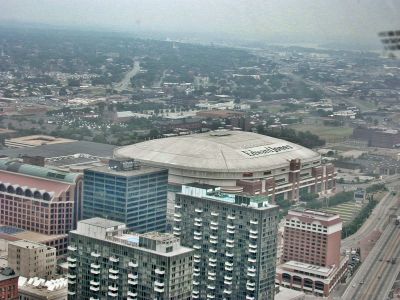 and while we
waited, we could study some posters that told about the history, development, and
the building of the Gateway Arch. When we arrived at the "tram" it turned out
that it consists of 8 small cabins, each with room for 5 people. These cabins
are coupled together and drawn up into the monument by cables. The climb to
the top takes four minutes and the trip down lasts 3 minutes. At the top of the
monument there are some small windows that gives some stunning viewa of St.
Louis and Illlinois on the other side of the river, but to look out you have
to lean forward and it may give an impression that you fall.
This causes some people to stay away from windows and stay in the middle of the
corridor. The only really
dangerous about it however, is entry and exit of the "tram", where the doors are only
4 feet high and made of metal. I, of course hit my head, when I entered, but
beside that nothing happened.
and while we
waited, we could study some posters that told about the history, development, and
the building of the Gateway Arch. When we arrived at the "tram" it turned out
that it consists of 8 small cabins, each with room for 5 people. These cabins
are coupled together and drawn up into the monument by cables. The climb to
the top takes four minutes and the trip down lasts 3 minutes. At the top of the
monument there are some small windows that gives some stunning viewa of St.
Louis and Illlinois on the other side of the river, but to look out you have
to lean forward and it may give an impression that you fall.
This causes some people to stay away from windows and stay in the middle of the
corridor. The only really
dangerous about it however, is entry and exit of the "tram", where the doors are only
4 feet high and made of metal. I, of course hit my head, when I entered, but
beside that nothing happened.
From the top there are great views. Unfortunately it was quite hazy due to the heat that was already high
here at half past nine. But we enjoyed what qwe could see from there like
Edward Jones Dome, home of St. Louis Rams. When there was no more to see,
we took the tram down, this time without me hurtinhg my head.
Once more on solid ground, we visited the local souvenir shop and bought
a couple of coffee mugs, and some
postcards, to send to to family and friends.
From The Arch we walked down to the river and found our riverboat. There were actually two that sailed from that particular wharf, and they were called, respectively, Tom Sawyer and Becky Thatcher after two of Mark Twain's famous characters. While we waited for the boat to sail, we were admiring some very beautiful black birds with distinctive red spots on the wings. Later I discovered that they were called redwinged blackbirds.
During the boat trip a park ranger told us
about the things we passed, but also the captain told a story or two.
Among other things we passed a power station, built in 1902. It was built to provide
power for the world exhibition in 1904 (remember Judy Garland with the song "Meet
Me In St. Louis, Louis, Meet me at the fair"?), And this was the first world
exhibition, which used electric lighting, and which therefore had
activities in the evening. In addition, we saw the
largest riverboat that ever sailed the Mississippi. It was laid up in 1978 and remained unused until 1995 when a consortium bought the vessel
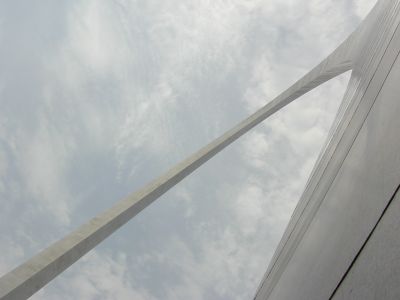 and
turnes it into a casino. When the riverboat was active, it could accommodate 4,500 passengers, making
it one of the world's largest passenger ships, and it was certainly the one with
the largest dance floor. 2,300 people could be on the dance floor simultaneously!
and
turnes it into a casino. When the riverboat was active, it could accommodate 4,500 passengers, making
it one of the world's largest passenger ships, and it was certainly the one with
the largest dance floor. 2,300 people could be on the dance floor simultaneously!
When the river tour was finished we
still missed one of today's tasks, finding a
gift for Tim. We therefore decided to take a metro train to Union Station.
Rides were free until 1 PM between Lacledes Landing and Union
Station, but unfortunately it was now later than that, so we had to pay for our
ticket. Before we got
that far though, we walked to the Edward Jones Dome, just to see if Sue had been wrong, and there would be a store with Rams merchandise. She had not!
We used that opportunity to visit a postoffice to buy stamps for the postcards
that we had written aboard the river boat. Then it was metrotime, and the trip
to Union Station probably lasted about 7-8 minutes. Union Station used to
be a station, but is not anymore. Today, the entire
station is converted to shops, restaurants, hotels, etc. One entire
floor of the center is devoted to food where you buy your food at a
counter and then eat at some tables in the middle - just like in the Old
Post Office Pavilion in Washington DC, which we visited in 2000. Our lunch
consisted of some salad with chicken and two bottles of water. When we had
finished eating, we walked around the mall, and found, among other things,
a "hat shop". Here they had hats and caps of all sorts, and we also found a St.
Louis Rams cap, which we bought for Tim. It turned out that the store also sold so called "mini-helmets."
That was football
helmets in mini size, and when Tim also wanted a Rams helmet, we decided to buy
a mini-helmet. The regular helmet was just too big to fit in the suitcase, on
our plane ride back home.
We also managed to find a sports shop which sold more Rams merchandise. There was
several models of jerseys, each with many different player names printed on the
back, so even though it was
late in Denmark, probably around 11 PM, we finally had to to call home to
Tim and ask him what kind he preferred, and which name should be one it. He mentioned a 4-5 names, and we managed to actually find a
jersey with one of these
names, so we bought it as well.
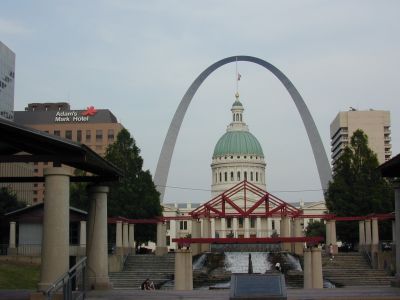 From Union Station, we decided to
walk back to the hotel instead of taking the
metro. When we exited Union Station, we discovered that it had been raining pretty much while we
were there, but it had already stopped. On the way back to the hotel we passed a
number of old buildings in town, such as the opera house, the old and the new city
hall, three different courthouses, one of which was no longer in use, a fountain and
some very fine sand castles, which, was being "built" on the occasion of
the upcoming 4th of July
celebrations, as the whole town was preparing for. We passed the old Cathedral
of St. Louis, today called "The Basilica of Saint Louis de France", which was the first cathedral
that was built west of the Mississippi River, but we didn't go inside the church.
We also walked by the towns Old Couthouse from 1828, where at least two famous historical
trials have begun, namely the case Dred Scott vs. Sanford, about a slave's right
to his freedom. The case went all the way to the U.S. Supreme Court where it was rejected
because the Supreme Court held that the Constitution did not apply to slaves and
that they therefore had no rights, and therefor could not sue! The second case, Minor vs.
Happersett was about the right of women to vote. Also, this case ended up in
U.S. Supreme Court, and again, the complainant lost when the court refused that Virginia Minor should have a constitutional right to vote. According to the
Constitution men and women were peers well enough, but individual states could
decide for themselves what rights, the two sexes should have, and these needed not
be identical. Furthermore, it was Minor's husband, who brought the case to court
as married women could not sue independently.
From Union Station, we decided to
walk back to the hotel instead of taking the
metro. When we exited Union Station, we discovered that it had been raining pretty much while we
were there, but it had already stopped. On the way back to the hotel we passed a
number of old buildings in town, such as the opera house, the old and the new city
hall, three different courthouses, one of which was no longer in use, a fountain and
some very fine sand castles, which, was being "built" on the occasion of
the upcoming 4th of July
celebrations, as the whole town was preparing for. We passed the old Cathedral
of St. Louis, today called "The Basilica of Saint Louis de France", which was the first cathedral
that was built west of the Mississippi River, but we didn't go inside the church.
We also walked by the towns Old Couthouse from 1828, where at least two famous historical
trials have begun, namely the case Dred Scott vs. Sanford, about a slave's right
to his freedom. The case went all the way to the U.S. Supreme Court where it was rejected
because the Supreme Court held that the Constitution did not apply to slaves and
that they therefore had no rights, and therefor could not sue! The second case, Minor vs.
Happersett was about the right of women to vote. Also, this case ended up in
U.S. Supreme Court, and again, the complainant lost when the court refused that Virginia Minor should have a constitutional right to vote. According to the
Constitution men and women were peers well enough, but individual states could
decide for themselves what rights, the two sexes should have, and these needed not
be identical. Furthermore, it was Minor's husband, who brought the case to court
as married women could not sue independently.